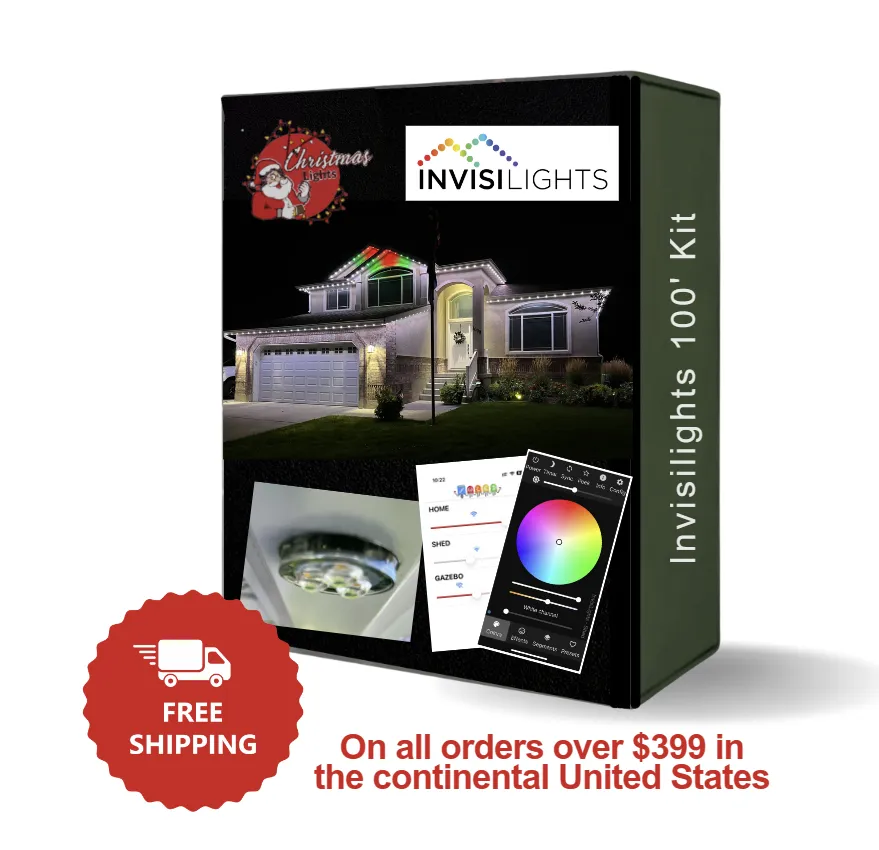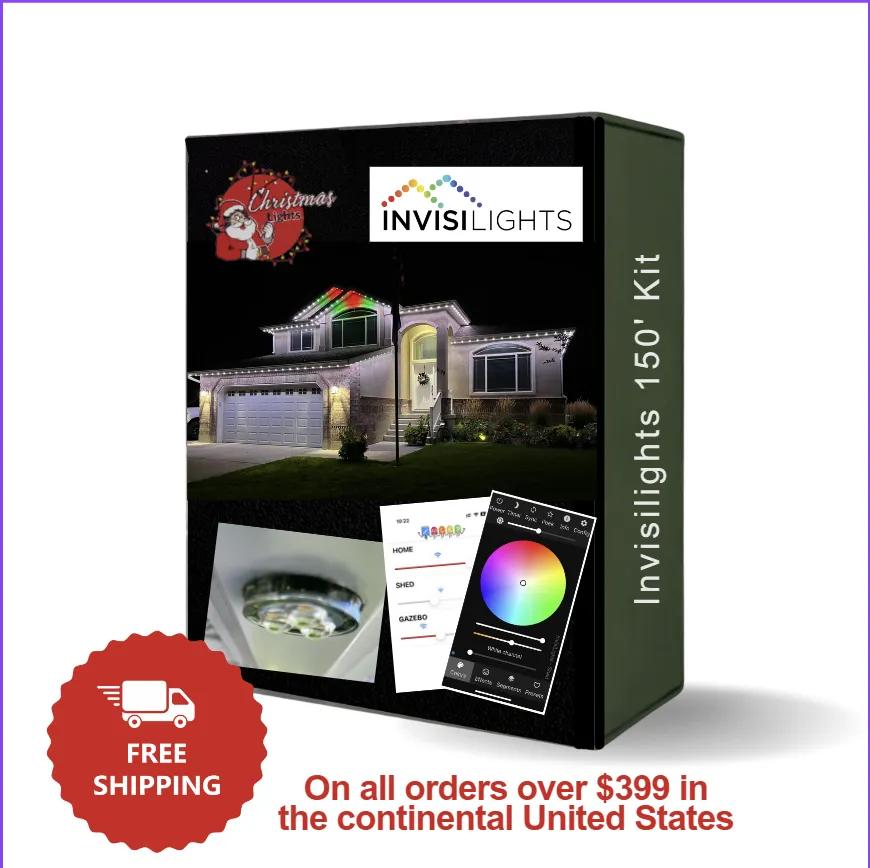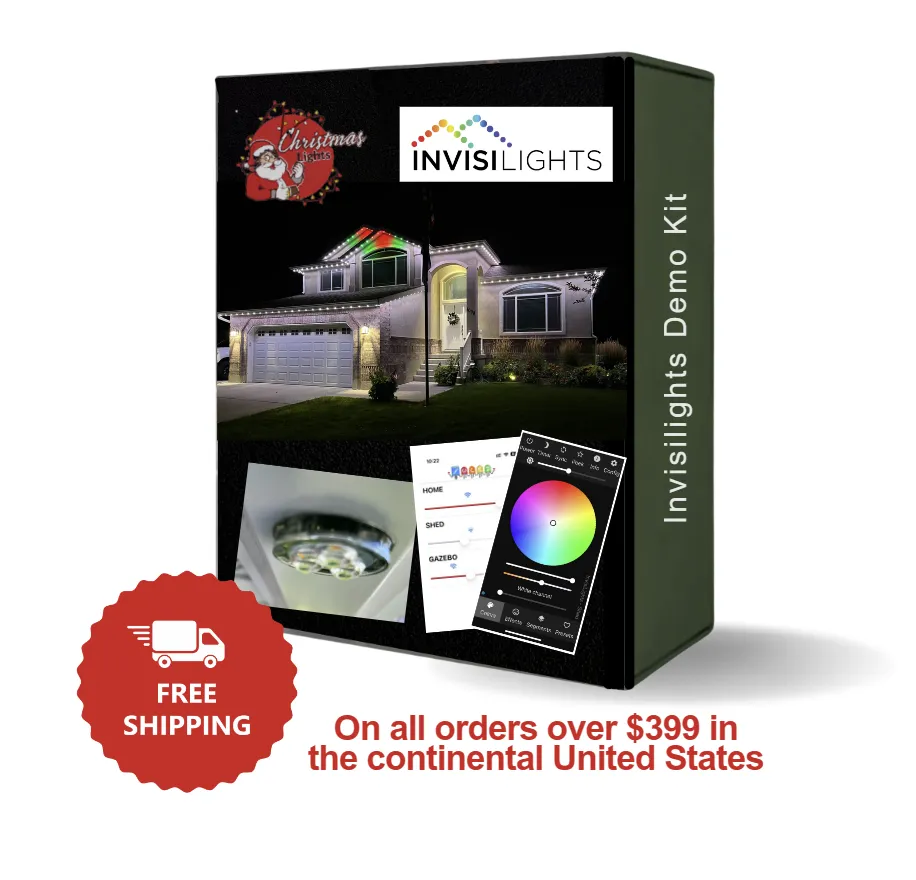Invisilights
Permanent Holiday Lighting
Customizable Lights for Any Event
WHAT YOU NEED TO KNOW BEFORE ORDERING
Total Linear footage of the installation.
This should include footage of lights and channel along with any Extensions or jumps you'll need to make
Where your controller box will be located
This is the most important step to planning out an installation, Without knowing where the controller will be you'll have no way to know the right materials to buy when it comes to extensions and accessories.
What Voltage system you want to use 24V or 36V
This is a decision you will make based on convince and efficiency, the most important factor with this will be the footage of each lighting run. If the total footage of a run is over 100' you'll need to either power inject on that run or switch to the 36V system that can go up to 200' before needing power injection.
Draw a Map
By mapping out the installation you'll be able to better understand and plan out the install giving you a better idea of what all you'll need to purchase to complete the job.
take the measurements from your map and add up the total number of materials you'll need.
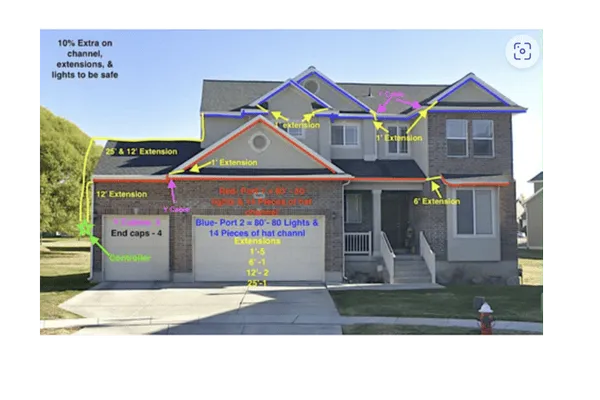
For the Map out example above the total material breakdown is:
System Voltage: 36V
Color of channel: Cameo
Channel Type: Hat
Total Lighted Footage: 160'
Power injection: NO
Controller: 1
Channel: 27- 6' sticks
Screws- 200
Lights: 175
1' extensions-7
6' Extensions-2
12' extensions-2
25- extensions- 1
Y Cables- 3
End caps- pack of 10
Absolute necessities
-Controller
-Lights
-Channel
-Screws
-Extension cables
Other Accessories
-Y Cable
-End Caps
- Signal boosters
-Power injection material
When would you need to power inject?
The controller will come with 3 outputs for your lighting runs, each 36V output can do a Max of 200', the 24V system can do a max of 100'. After that max you'll need to inject power. After you do so you can go an additional 100' with the 24V or 200' with the 36V system.
Power injection is needed due to voltage drop, voltage drop happens due to the length traveled away from the power source along with the gauge of the wire. due to the gauge of wire the lights and extensions run on it drops in voltage enough at 100' with the 24V system and 200' with the 36V system to effect the lights performance requiring a addition of power (Power Injection)
Materials needed for power injection 36V
Power injection pig female pig tale
Power injection Extension cables
Power injection T Cable.
Materials needed to Power inject 24V
16/2 - 12/2 Low voltage landscaping wire
Cut and Splice T cable
Water Proof Wire connectors
Discover the Transformative Power of Invisilights: Expertly Installed Permanent Lighting Solutions
Enhance your installation offerings with Invisilights, the premier permanent lighting solution designed for seamless integration into any property’s exterior architecture.
Crafted with high-quality aluminum channels and advanced LED technology, Invisilights delivers durability and superior energy efficiency—key selling points for your clients seeking long-lasting, cost-effective lighting solutions. Our system not only provides brilliant illumination but also boosts the aesthetic appeal and functionality of any home.
Offer your clients peace of mind with our robust 5-year warranty, ensuring reliable performance and minimal maintenance needs. This warranty supports your commitment to quality and customer satisfaction, making it easier for you to sell and install with confidence.
Our flexible, programmable system allows you to meet any client’s specific desires—from subtle accents to full-scale holiday displays—making it an adaptable choice for various applications. With Invisilights, you can cater to a wide range of preferences and needs, increasing your market reach and customer retention.
Choose Invisilights for your installations and add a transformative product to your portfolio that will impress clients and ensure your services remain in demand for years to come.
Frequently Asked Questions
What exactly comes in the 150' InvisiLights permanent outdoor lighting kit?
The InvisiLights kit is comprehensively equipped to ensure you have everything you need for installation. Each kit includes:
27 sticks of 6-foot Aluminum Channel to house and protect the lighting elements.
150 feet of dynamic RGBW LED Lights, which includes 23 sets of 6-count and 14 sets of 1-count lights, allowing for extensive coverage and diverse configuration options.
2 Data Boosters to enhance signal strength across the lighting installation, ensuring consistent control and color output.
A 320W Power Supply capable of supporting up to 190 puck lights, providing ample power for even the most extensive setups.
1 GFCI Outlet Adapter to ensure safe outdoor electrical connections.
1 Controller that allows you to manage and customize the lighting effects easily.
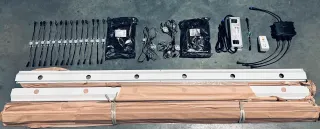
Will I need any additional components besides what's included in the Invisilights permanent lighting kit?
While the Invisilights kit comes with all the essential components for a standard installation, there are a couple of scenarios where you might need additional items:
Jumper Wires: Depending on the layout of your installation and the number of gaps or 'jumps' between the sections of lights, you may require jumper wires. These wires help bridge the gaps without losing the continuity of the light sequence, ensuring a smooth and uniform display across more complex architectures.
Data Boosters: If any section of your lighting setup is more than 15 feet away from the control box, additional data boosters will be necessary. Data boosters help maintain the integrity and brightness of the lights over longer distances, ensuring consistent performance throughout your installation.

Can I choose the color of the aluminum channel for my InvisiLights kit?
Yes, you can select your preferred color for the aluminum channel to match your home’s exterior or personal taste. Please make sure to specify your color choice in the notes at checkout when you place your order.
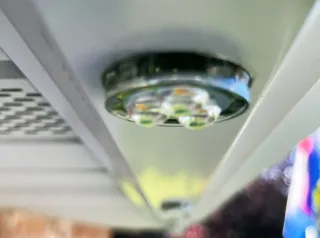
How do the included components of the InvisiLights kit enhance the lighting system?
Each component in the InvisiLights kit plays a crucial role in creating an effective and stunning lighting display:
Aluminum Channels: Provide a durable, weather-resistant housing for the LED lights, which helps in maintaining a clean and nearly invisible look during the day.
RGBW LED Lights: Offer vibrant, full-spectrum color and white light combinations, making it perfect for any occasion from festive holidays to elegant ambient lighting.
Data Boosters: Ensure that the signal remains strong across longer distances, which is crucial for larger installations.
Power Supply: Designed to efficiently handle the energy needs of the system without overload, ensuring safety and durability.
GFCI Outlet Adapter: Adds an extra layer of safety by protecting against electrical shorts and surges, particularly important in outdoor settings.
Controller: Provides the flexibility to customize and control the lighting sequences, colors, and patterns right from your smartphone or controller, adding convenience and advanced functionality to your lighting system.
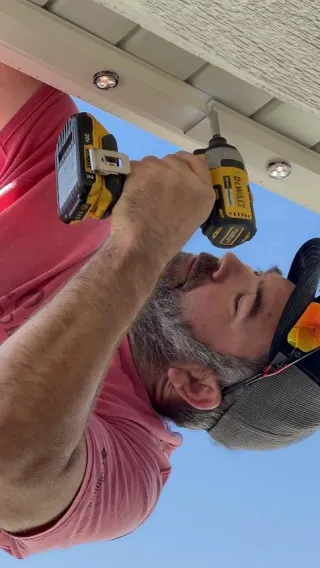
Can I use Invisilights year-round?
Absolutely! Invisilights are designed for versatile use throughout all seasons. Whether you're celebrating a special occasion, setting a mood for a party, Love your favorite sports team, or simply enhancing your home's ambiance, our lighting systems provide the perfect solution for any event, big or small.
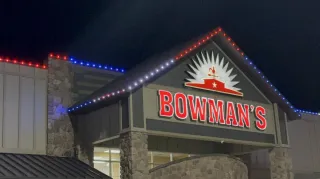
Can I set timers and events for Invisilights?
Yes, Invisilights feature advanced programmable settings that allow you to schedule lighting for specific events and automate timers. This functionality ensures that your lighting preferences are perfectly aligned with your lifestyle, turning on and off at predetermined times without any manual intervention.

Is it possible to achieve warm or soft white with Invisilights?
Absolutely, Invisilights are equipped with RGBW technology, which includes a dedicated white LED alongside the standard red, green, and blue LEDs. This addition allows the system to produce authentic warm white, soft white, and various other shades of white with greater accuracy and intensity compared to traditional RGB systems. This capability ensures that you can effortlessly tailor the lighting to fit the desired ambiance and aesthetic of any environment, providing precise control over both vibrant colors and the subtlety of different white tones.
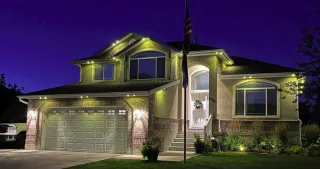
How do you ship your product?
Our products are shipped directly from our warehouse using reliable shipping carriers to ensure timely and safe delivery. Each product is securely packaged to prevent damage during transit, and we provide tracking information so you can follow your order’s journey to your doorstep.
Where are the controller and power supplies installed?
The controller and power supplies for Invisilights are typically installed in an accessible location such as a garage or utility room. These components connect to your home’s WiFi network, allowing seamless control over the lighting system via our user-friendly mobile app.
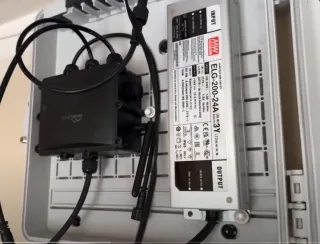
How long do Invisilights last?
Invisilights are engineered to last, with each LED bulb boasting a lifespan of over 50,000 hours. Given a typical usage of 10 hours per night, this translates to approximately 5,000 nights. This means your Invisilights could illuminate your home's exterior for nearly 14 years under these conditions, ensuring that your investment not only adds beauty but also long-term value to your property.
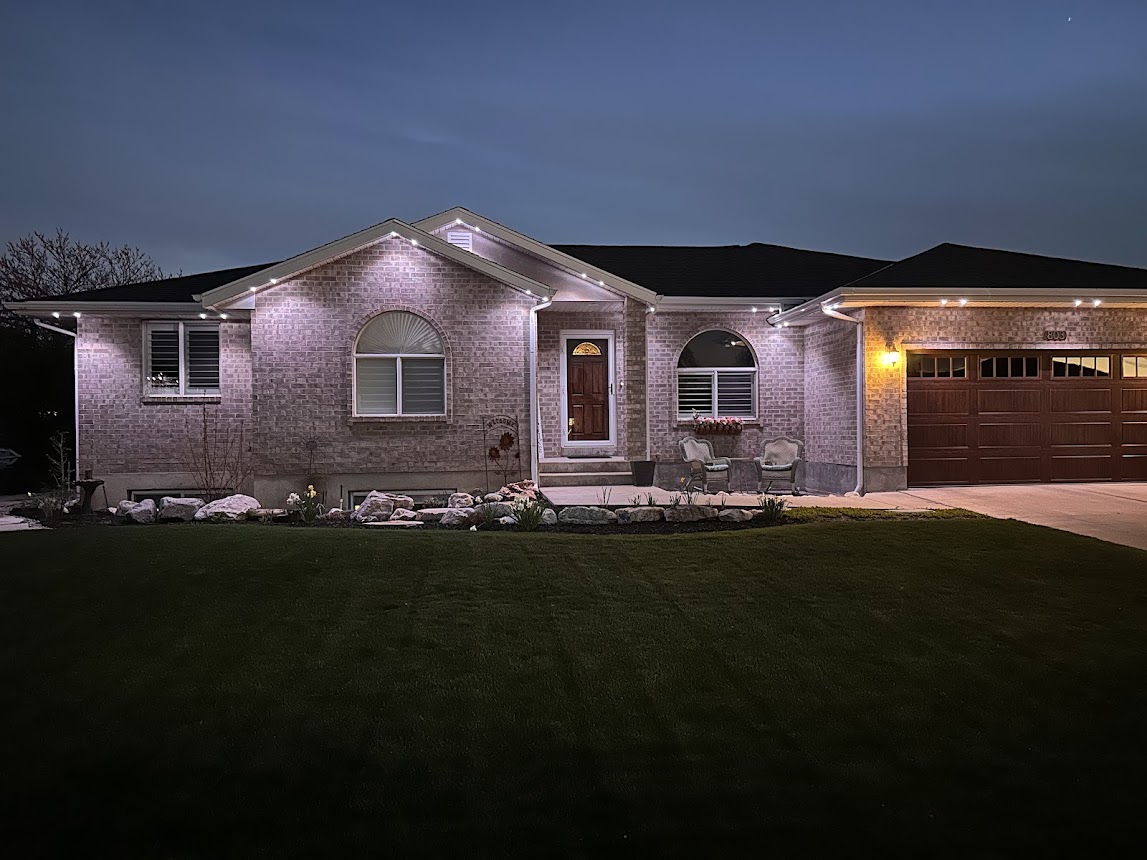
Are Invisilights dimmable?
Yes, all Invisilights are fully dimmable. This feature allows you to adjust the intensity of the light to suit various occasions, from a soft glow for a romantic evening to bright, vibrant colors for a festive celebration.

What types of custom channels are available?
Invisilights offers two types of custom channels, available in 40 different colors, ensuring a nearly invisible installation. These channels are designed to blend seamlessly with your home’s architecture, providing discreet yet effective lighting.

Can I control different zones independently?
Yes, the Invisilights system supports multiple zones which can be controlled independently or synchronized. This functionality allows for intricate lighting designs that can vary across different areas of your home, enhancing the overall impact and utility of your installation.
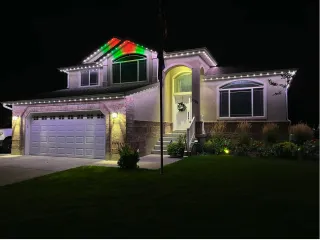
What is outdoor permanent lighting?
Permanent lighting refers to architectural-grade lighting systems that are installed permanently on your property to provide year-round illumination.
How does permanent lighting differ from traditional holiday lighting?
Unlike traditional holiday lighting, which is typically temporary and used only during specific seasons, permanent lighting is installed once and can be used throughout the year for various occasions
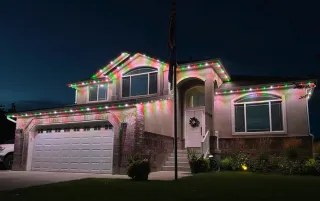
Discover Expert Tips on Our Blog

Christmas Lights: From Takedown to Storage Solutions
As the holiday season winds down, professional Christmas light installers face the critical task of efficiently and safely removing lights while ensuring proper storage for next year's installation. This isn't just about taking down lights; it's about maintaining your investment, protecting your reputation, and setting yourself up for success in the following season. A well-executed takedown process can save countless hours during next year's installation and prevent thousands of dollars in potential damage to both equipment and client properties. This comprehensive guide will walk you through the best practices for Christmas light takedown, storage, and organization to help streamline your operations and maximize your business's efficiency.
Planning Your Route for Efficient Takedown
The cornerstone of efficient takedown operations lies in careful route planning. A well-planned route can help you complete 10-15 jobs per day, potentially doubling or even tripling your productivity compared to unplanned routes. This efficiency isn't just about saving time – it's about maximizing your crew's energy, minimizing fuel costs, and ensuring you can maintain consistent quality throughout the day. Many professionals underestimate the impact of proper route planning, but it can be the difference between completing five jobs and fifteen jobs in a single day.
Several powerful tools are available for optimizing your route planning process:
Jobber: Built-in route optimization with higher-tier plans, offering real-time updates and team coordination features. Jobber can automatically account for traffic patterns and optimize routes for multiple crews simultaneously.
Road Warrior: Offers sophisticated CSV file upload capability for efficient routing, allowing you to import hundreds of addresses at once and create optimized routes within minutes. The platform can factor in time windows, vehicle capacities, and priority customers.
ChatGPT: Leverages AI for route optimization from customer lists, providing creative solutions for complex routing scenarios and helping identify efficient groupings of nearby customers.
Google Maps: While more basic, it offers custom route creation for multiple stops and can be particularly useful for smaller operations or when working in familiar areas.
CRM Integration: Most modern CRMs offer address export capabilities for route planning, allowing you to leverage your existing customer data for takedown logistics.
The biggest challenge with completing multiple jobs per day isn't usually the takedown itself—it's managing the logistics of transporting all the materials. A standard residential job might require storage space for hundreds of feet of lighting, dozens of extension cords, and various accessories. Having adequate vehicle space and proper storage containers becomes crucial when you're handling multiple takedowns efficiently. A well-organized trailer or truck system can make the difference between making multiple trips to your storage facility and completing all your daily jobs in one smooth run.
Consider implementing a mobile storage system where bins or containers are pre-labeled and organized by route. This allows crews to quickly load and unload materials while maintaining organization throughout the day. Many successful companies use a color-coding system for their storage containers that corresponds to different areas of their service region, making it easy to sort and store materials as they're removed from each property.
Installation Techniques That Make Takedown Easier
The secret to fast takedown actually begins months earlier during installation. When you install lights properly, most jobs can be completed without ever climbing a ladder – a fact that not only increases efficiency but dramatically improves worker safety. This approach focuses on installation methods that facilitate easy removal while maintaining a professional appearance throughout the season. The most successful installers think about takedown from the moment they begin installation, incorporating techniques that will save hours of labor when the season ends.
Key installation principles for easy takedown:
1. Avoid excessive zip-tie use - limit yourself to only what's necessary for security, and position them for easy cutting during removal
2. Never wrap wires around metal fixtures - this creates unnecessary tangles and can damage both the lights and the fixture
3. Skip adhesives and glue - these create permanent attachment points that can damage property and make removal extremely difficult
4. Use proper clips designed for easy removal - invest in quality clips that grip firmly but release cleanly
5. Always install with removal in mind - think about how each attachment point will be accessed during takedown
6. Utilize tools like Mr. Long Arm or water-fed poles - these allow for installation and removal from the ground

Professional installers who follow these principles find that most residential jobs can be completed in 10-15 minutes during takedown. This efficiency comes from the ability to simply reach up with an extension pole, hook the light strand, and pull it down in one smooth motion. The lights should "zip" down the roofline, maintaining their organization as they come down.
Each attachment point should be designed with removal in mind. For example, when installing clips on gutters, position them so they can be easily unclipped from the ground using a pole with a hook attachment. When working with peak lights, consider using special clips that can be removed with a gentle pull rather than requiring direct manipulation. These small considerations during installation can save hours during takedown.
The proper use of tools is crucial for efficient takedown. A quality extension pole system with various attachments can handle most takedown situations. Important tools include:
* Hook attachments for pulling down light strands
* Clip removal tools for stubborn attachments
* Poles with adjustable angles for difficult corners
* Light-weight but sturdy poles that can extend to necessary heights
Documentation and Organization Systems
Proper documentation during takedown becomes your roadmap for next year's installation, potentially saving hours of planning and preventing costly mistakes. Digital documentation tools like Company Cam (approximately $19 per user per month) have revolutionized how professionals track their installations and takedowns. These platforms offer features that go far beyond simple photo storage, providing a comprehensive system for managing your installation records.
Documentation best practices include:
* Taking detailed photos of each installation from multiple angles
* Creating digital annotations showing attachment points and special considerations
* Drawing rough sketches of rooflines with measurements
* Marking specific challenges or unique features of each property
* Storing information by address for easy retrieval
* Maintaining records for damage protection and customer disputes
* Recording any special requests or preferences from the customer
* Documenting the types and quantities of materials used
Physical documentation remains equally valuable, particularly for on-site reference. Many successful installers create detailed installation maps on invoice backs, providing quick reference during both takedown and next season's installation. These physical documents often include:
* Rough sketches of the property layout
* Notations about specific attachment points
* Material quantities and types used
* Special instructions for unique features
* Color-coding systems for different sections
* Notes about potential hazards or challenges
The most effective documentation systems combine both digital and physical methods, creating redundancy and ensuring that critical information is always available. During takedown, crews can quickly reference these documents to ensure they're removing everything properly and storing it in a way that will make sense for next year's installation.

Light Organization and Storage
Implementing a well-planned organization and storage system is crucial for maintaining your investment in professional lighting equipment. A straightforward labeling system, such as the industry-standard color-coded zip tie system, can save dozens of hours during next year's installation season and prevent thousands of dollars in replacement costs due to damaged or misplaced lights. The most successful companies treat their storage systems as a critical business process, not an afterthought. Here's a breakdown of the color-coded zip tie system used:
First Floor: Use one red zip tie on the right side as the starting point for all installations, with additional markers to indicate specific sections or features like columns or doorways.
Second Floor: Use two red zip ties to clearly differentiate from first-floor sections, possibly combined with additional markers for specific areas.
Peaks (from right to left): Assign zip ties progressively (one for the first peak, two for the second, and three for the third), consider using a different color for peaks to enhance distinction, and add special markers for different pitch angles or challenging access points.
Wrapping Lights for Storage
When it comes to wrapping lights for storage, consistency is key. Professional installers have developed specific techniques to prevent tangling and protect both bulbs and wiring. For string lights, it's crucial to maintain all clips and bulbs in their original positions since removal and reattachment can waste valuable time and risk damage. Instead of creating tight balls or random bundles, adopting a systematic folding pattern can make a significant difference:
Start by grabbing the end of the strand.
Count out a length equivalent to 5-6 bulbs.
Carefully fold this section, keeping the bulbs aligned.
Continue this pattern until you reach the end of the strand.
Secure the bundle with the end of the cord.
Immediately add any necessary labels or markers.
This methodical approach results in neat, manageable bundles that easily unfold during the next year's installation. Many professionals find that spending an extra 30 seconds properly folding each strand can save 5-10 minutes during reinstallation.
Storage Containers
Choosing the right storage container requires careful consideration of various factors. Here's an overview of the options available:
Plastic Totes:
Advantages: Plastic totes are extremely durable, weather-resistant, and readily available at most hardware stores. They are stackable, which makes for efficient use of space, and can last multiple seasons.
Disadvantages: These totes often lack proper ventilation, which can trap moisture, necessitating the drilling of drainage holes. Their tapered sides can make space use inefficient, and they generally have a higher initial cost than other options.
Best Practices: To mitigate moisture issues, drill ventilation holes and place desiccant packets inside. Store them in climate-controlled areas and label each tote clearly with contents and customer information.
Cardboard Boxes:
Advantages: Cardboard boxes provide excellent ventilation and are very cost-effective. They are easy to label and modify, collapsible when not in use, and biodegradable if damaged.
Disadvantages: Their durability is limited, and they are susceptible to moisture damage, which may necessitate seasonal replacement. They are also less stable when stacked.
Best Practices: Reinforce corners and edges to enhance durability, store them away from direct ground contact, use waterproof markers for labeling, and consider double-walling boxes for additional strength.
Fruit Trays:
Advantages: Fruit trays offer superior ventilation and are extremely space-efficient when stacked. They are durable yet lightweight and often come with built-in document holders. They are also collapsible for easy storage during the off-season.
Disadvantages: These trays can be difficult to source and require a higher initial investment. They may also need special storage racks and typically offer limited size options.
Best Practices: Develop relationships with local produce vendors to ensure a steady supply, install document pouches for organizing customer information, create standardized systems for stacking, and consider color-coding for different products or areas.

Storage Locations
The choice of storage location can significantly affect the longevity of your professional Christmas light installations, which represent a substantial capital investment, often totaling tens of thousands of dollars in inventory. Proper storage conditions can extend the lifespan of your lights by several seasons, whereas poor storage can render them unusable after just one off-season.
Critical Environmental Factors to Consider:
Temperature Stability: It's crucial to avoid extreme temperature fluctuations.
Humidity Control: Prevent condensation and corrosion by controlling humidity levels.
Chemical Exposure: Keep lights away from harsh chemicals such as cleaning supplies and pool chemicals.
Light Exposure: Minimize UV damage to plastics and insulation to preserve integrity.
Pest Control: Ensure that the storage area is secure from rodents to prevent damage to wiring.
Physical Security: Protect your investment against theft and vandalism.
Personal Storage Solutions:
Garage Storage: While readily available and convenient, garages often lack climate control and can have limited space, with potential competing uses.
Basement Storage: Basements are usually temperature stable and offer good security, although they may have issues with humidity, and access can be challenging.
Workshop/Shed Storage: These offer a dedicated space that can be customized to business needs but may lack climate control and have security concerns.
Commercial Storage Options:
Rental Units (10x20 typical): Managed professionally with options for climate control, these units often provide 24/7 access but come with higher operating costs ranging from $2,000 to $3,000 annually.
Warehouse Space: Ideal for scalable operations as the business grows, warehouses provide professional environments with loading docks and equipment, albeit at the highest cost.
Shared Storage Facilities: These facilities allow you to split costs with other businesses, offering flexible space options. However, they might present potential scheduling conflicts and less control over the environment.

Business Considerations and Operational Planning
The business aspects of Christmas light takedown are a critical component of the annual business cycle for successful companies, integrating deeply into their broader operational strategy beyond just the physical removal of lights. Effective pricing strategies are essential, typically ranging from $8-12 per foot for both installation and takedown, with additional charges for complex architectural features. Companies might offer early booking incentives, volume discounts for large properties, premium rates for rush services, and special pricing for commercial clients.
Scheduling is another crucial consideration during the takedown season. Companies should start planning their takedown routes before the installation season concludes, taking into account weather patterns, seasonal changes, customer preferences, and property access. It's important to balance crew availability with equipment needs and maintain flexibility for unexpected situations, while also planning for regular equipment maintenance and inventory checks.
Customer communication is integral to the process, starting with setting clear expectations during the initial installation. Detailed takedown scheduling options should be provided, along with incentives for early booking. Regular updates about timing, proactive handling of special requests, and follow-ups after service completion help maintain good customer relations and set the stage for discussions about the next season.
Lastly, crew management requires careful attention. Companies need to provide comprehensive training on takedown procedures, establish clear quality control standards, and implement safety protocols for winter conditions. Efficient documentation procedures should be created to track progress and issues, and backup plans developed for equipment failures. Maintaining robust communication systems between teams is essential to enhance coordination and efficiency.
Professional Christmas light takedown represents a critical junction in the annual cycle of a successful holiday lighting business. The care and attention given to this phase directly impacts both customer satisfaction and operational efficiency for the following season. By implementing comprehensive systems for planning, documentation, storage, and business management, companies can transform what many view as a necessary chore into a strategic advantage.
Success in this industry requires more than just technical skill - it demands a systematic approach to every aspect of the operation. From the initial installation planning to the final storage preparation, each step builds upon the others to create a sustainable and profitable business model. Companies that master these processes find themselves well-positioned for growth, with satisfied customers and efficient operations providing a strong foundation for future success.
The business aspects of Christmas light takedown are an integral part of the annual business cycle for successful companies, not merely the physical removal of lights. This process is woven into the broader operational strategy, considering various elements from pricing to crew management.

How many Christmas light takedown jobs can be completed in one day?
With proper route planning and organization, a professional team can complete 10-15 jobs per day. The key limiting factor isn't usually the takedown itself but rather the logistics of transporting and storing the materials. To achieve this level of efficiency, you need adequate vehicle space, proper storage containers, and a well-planned route that minimizes travel time between locations.
Do I need to use a ladder for Christmas light takedown?
When lights are installed correctly, most takedown jobs can be completed without ever using a ladder. The key is using tools like Mr. Long Arm or water-fed poles with hook attachments. By installing with takedown in mind and using proper clips, lights should be able to "zip" down quickly and safely from ground level. The only exceptions might be for mini lights on columns or specific architectural features that require closer access.
What's the best way to store Christmas lights after takedown?
There are several effective storage methods, but one of the most efficient is using fruit trays or similar ventilated containers. When storing lights, keep all clips and bulbs attached, and wrap them in consistent sections rather than tight balls. Count out 5-6 bulbs' length, fold them together, and secure the ends. For mini lights, create neat balls and connect the male and female ends together. Always ensure proper ventilation in your storage containers to prevent moisture damage.
How should I label my lights for easy installation next year?
Implement a simple color-coded zip tie system. For example, use one red zip tie on the right side for first-floor lights, two red zip ties for second-floor lights, and number your peak lights from right to left (one zip tie for first peak, two for second, etc.). Keep your labeling system consistent and document it for your crew. This system makes it easy to quickly identify where each strand belongs during next year's installation.

What's the best way to document installations for next year?
Use a combination of digital and physical documentation. Digital tools like Company Cam ($19/user/month) allow you to take photos, make annotations, and store everything by address in the cloud. Additionally, create physical installation maps on invoice backs, drawing rough sketches of rooflines and noting attachment points. This dual approach ensures you have reliable references for next year's installation and provides protection against potential damage claims.
What should I avoid when taking down Christmas lights?
Avoid rushing the takedown process and damaging either the lights or the property. Never pull lights down aggressively if they seem stuck - this usually indicates they were installed with adhesives, wrapped around fixtures, or secured with too many zip ties. Also, avoid storing wet lights or placing them in non-ventilated containers, as this can lead to corrosion and damage.
How can I optimize my takedown route?
Several tools can help optimize your route: Jobber's built-in route optimization, Road Warrior for CSV file uploads, ChatGPT for route planning, or even Google Maps for custom routes. Export your customer list from your CRM and use these tools to create the most efficient path between jobs. Consider factors like property proximity, traffic patterns, and time windows for optimal routing.
What should I consider when choosing a storage location for my lights?
Choose a storage location with proper ventilation and protection from extreme temperatures and moisture. Avoid storing lights near chemicals, especially bleach, which can cause deterioration. Options include personal storage (garage, basement), commercial rental units (typically 10x20), or warehouse space. Consider accessibility, security, and climate control when making your choice. The cost for a commercial unit typically ranges from $2,000-3,000 annually for a 10x20 space.
How should I handle ridge clips during takedown?
The approach depends on the type of ridge clips used. For newer slide-in models (like Best Clips), you can usually leave the clips attached to the lights during storage. For standard ridge clips, it's often better to remove them and store them separately, clicking them back together in their original strips. This prevents tangling and makes next year's installation more efficient.
What pricing structure should I use for takedown services?
Include takedown in your initial installation pricing, typically charging between 8-12 dollars per foot for the complete service. This comprehensive pricing ensures you're compensated fairly for both installation and removal. Consider offering early booking discounts for customers who allow you to schedule takedown before October 31st, as this helps manage your schedule more efficiently and allows you to focus on new installations during peak season.
Copyright ©2024 All Right Reserved website designed by christmaslights.io
Terms of Service / Privacy Policy
Have questions or need assistance?
Contact us at (855)619-LITE


